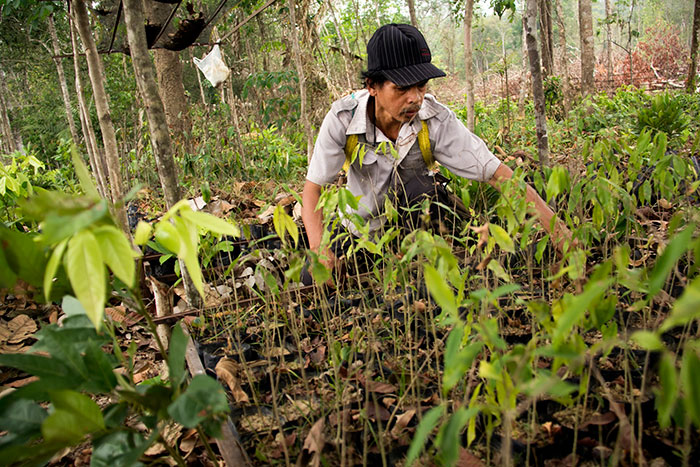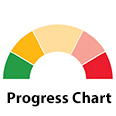Life on land

Petrus Asuy sows forest crop seeds in his nursery in East Kalimantan, Indonesia, where Indigenous communities fight land loss due to coal mining and plantations through reforestation.
© Climate Visuals Countdown/Michael Ekoclose remaining gaps to protect vital terrestrial ecosystems.
Shifting forest trends show progress and setbacks to halt deforestation
Forests covered about 4.1 billion hectares (31 per cent) of the world’s land surface in 2020. From 2000 to 2020, forest coverage shrank by about 100 million hectares. While afforestation, forest restoration and natural forest expansion led to some gains, losses from deforestation dominate; agricultural expansion was the main driving force, accounting for nearly 90 per cent of forest loss. Regional trends vary: Asia, Europe and Northern America saw forest growth, while Latin America and sub-Saharan Africa experienced significant losses, driven by livestock grazing and cropland expansion, respectively.
Deforestation is slowing, with the rate falling from 12 million hectares per year (2010–2015) to 10 million (2015–2020). While this is progress, at the current rate, halting deforestation, as called for in Goal 15, would take another 25 years. Recent data show notable progress in certain countries. Indonesia reduced deforestation by 14 per cent in 2021–2022 compared to 2020–2021. Brazil cut deforestation in the Legal Amazon by 50 per cent in 2023 compared to 2022. There are also signs that deforestation is slowing across the African continent.
Forests face mounting climate pressures, with intensifying wildfires and invasive species. Wildfires emitted an estimated 6,687 metric megatons of CO₂ globally in 2023, more than double the emissions from fossil fuels by the European Union. Meanwhile, global wood production has reached a record high of 4 billion cubic metres annually, while nearly 6 billion people depend on non-timber forest products. Global roundwood demand could rise by 49 per cent by 2050.
Annual rate of forest expansion and deforestation, 1990–2020 (million hectares per year)

Significant investments in restoration are needed to achieve land degradation neutrality
Land degradation extends beyond environmental harm, undermining human health, driving poverty, worsening food insecurity and fueling migration. Each year at least 100 million hectares of land (the size of Egypt) become degraded. Between 2015 and 2019, the global proportion of degraded land increased from 11.3 to 15.5 per cent, undermining the well-being of 3.2 billion people. Achieving a land-degradation-neutral world by 2030 requires the restoration of approximately 1.5 billion hectares.
While voluntary commitments have pledged to restore over 1 billion hectares of land, with large-scale restoration initiatives in sub-Saharan Africa, Central America, Central Asia and the Middle East, restoration efforts on the ground are advancing too slowly. Investments in land restoration deliver substantial returns, with each dollar invested yielding $7 to $30 in benefits. Yet, financing is insufficient. According to the United Nations Convention to Combat Desertification (UNCCD), combatting desertification, land degradation and drought demands $1 billion per day between 2025 and 2030. But current annual funding stands at $66 billion, just 18 per cent of estimated needs. Without a significant scale-up in financing and implementation, losses in productivity, resilience and biodiversity will continue to mount.
All major species groups are in decline on the Red List Index
Species extinction is irreversible, resulting in the permanent loss of biodiversity and threatening humanity’s well-being. Over 47,000 species are threatened with extinction, with all major species groups on the Red List Index in decline ‒ especially corals, amphibians and cycads. Since 1993, the Index has deteriorated by 12 per cent, with sharpest declines in Southern Asia and Eastern and South-Eastern Asia, while the least severe are in Northern America and Central Asia. These regional differences reflect differences in consumption patterns, governance capacity, conservation funding and the vulnerability of tropical species with small range sizes.
New assessments show rising threats to freshwater species, including fish, dragonflies, crabs and shrimps ‒ one in four now threatened by pollution, dams, agriculture, invasive species and overharvesting. Trees are also at risk: 38 per cent of the assessed 47,282 species face extinction as a result of habitat loss, overexploitation, climate change, pests and diseases. This impacts entire ecosystems and human livelihoods. Encouragingly, site conservation and restoration, invasive species response and ex situ conservation are proving effective. Scaling up such efforts is vital to halt and reverse biodiversity loss and prevent ecosystem collapse.
Red List Index of species survival, 1980–2024

Note: A Red List Index value of 1.0 means that all species are categorized as of “Least concern”; hence, none are expected to become extinct in the near future. A value of zero indicates that all species have gone extinct.
Average protection of key biodiversity areas has nearly doubled, but most remain at risk
Since 2000, significant progress has been made in biodiversity conservation through protected and conserved areas. SDG target 15.1 was achieved by 2020, with 17.6 per cent of terrestrial and inland areas now under protection. The Kunming-Montreal Global Biodiversity Framework now calls for 30 per cent coverage by 2030. Safeguarding KBAs ‒ sites vital for species and ecosystems ‒ is among the most impactful conservation approaches. While 68 per cent of KBAs are partially or fully within protected and conserved areas, the global average has plateaued, rising from 25 to 44 per cent since 2000 but showing limited progress after 2015.
Real-world successes offer hope: Mozambique’s Chimanimani National Park, designated in 2020, safeguards many threatened amphibian and plant species; Redonda Island (Antigua and Barbuda) has been restored and 30,000 hectares protected following the removal of invasive species; Canada’s coastal First Nations communities lead KBA monitoring; and over 3 million trees have been planted in restoring Madagascar’s Kianjavato Classified Forest KBA. These efforts highlight what is possible ‒ and exemplify the ambition required to meet global targets.
Mean proportion of mountain, inland freshwater, terrestrial and marine KBAs covered by protected areas, 2000, 2015, and 2024 (percentage)

Upward trend observed in biodiversity-related official development finance
Total development finance for biodiversity from various sources rose from $9.5 billion in 2015 to $11.9 billion in 2023, marking a 25 per cent increase. Official development assistance (ODA) accounted for an average of 97 per cent of total flows over this period. Despite rising biodiversity finance, flows targeting biodiversity as a principal objective declined by 17 per cent, from $4.6 billion in 2015 to $3.8 billion in 2023. Biodiversity represents a relatively small share of total development finance ‒ just 7 per cent. Private finance for biodiversity has more than doubled, from $748 million in 2021 to $1.8 billion in 2022, with preliminary 2023 figures approaching $4 billion. Still, this remains modest compared to areas like climate change, which averaged $16.1 billion annually between 2017 and 2022. Meeting the Global Biodiversity Framework’s financing targets will require greater mobilization of both private and public flows.
Bilateral flows of official development finance (ODF) for biodiversity (as a principal or significant objective) from members of the Development Assistance Committee, 2015–2023 (billions of dollars)


